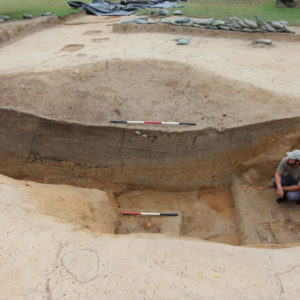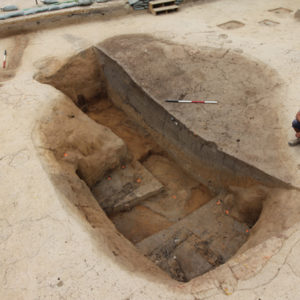Jamestown Rediscovery archaeologists have been investigating a fort-period structure and associated cellar outside of James Fort’s original triangular palisade. The structure stood near the location of where the Preservation Virginia entrance gate is today and just north of the 1907 Memorial Church. In August the team continued to excavate the cellar and also examined postholes from a fence line that projected from the building's corner.
In 1608 the fort was expanded from 3- to 5-sided and this structure appears to have been incorporated into the extended fort palisade at that time. In that way it would mirror Structure 165, "The Factory" building that was found several years ago just outside the original southeastern bulwark of the fort.
"This building could have acted as an outer defense to the main part of the fort," Kelso said. "This was a substantial structure, right at the corner but extended from it so that it could act as a bulwark where a cannon could protect the flanks."
One of the more significant findings in August was confirming that a feature in the bottom of the cellar is another well. In 22 years of research, the Jamestown Rediscovery team has excavated several James-Fort-period wells that have held hundreds of thousands of artifacts. Although the team will have to wait to begin digging this new well, at least until the cellar fill has been completely excavated, it could be similar in construction to the Fort's first well, which Jamestown Rediscovery archaeologists discovered in the cellar of a storehouse.
"The cellar of this new building was built in at least two phases. It is unclear at this stage whether or not the well was part of the first or second phase of the cellar. If it dates to the first phase, the well would have been covered when the floor of the cellar was raised about a foot during the its second phase of use," said Dr. William Kelso, Director of Archaeology for Jamestown Rediscovery.
The floor surface also exhibited a thin layer of processed animal bones—goose, duck, turkey, pig, and sturgeon—across one section.
“Is this a kitchen? We don’t know yet, but you can imagine the colonists down here in the winter, eating and hunkering down to take advantage of the natural warmth of the deep soil there," Kelso said.
In August the Jamestown Rediscovery archaeologists also looked more closely at post holes extending north from the cellar in what appears to be a fence line. “We think the fence attaches to this building somehow. It’s on the same axis," Kelso said. "It’s also pretty clear that it is a paling more like a high heavy picket fence rather than a side-by-side upright log palisade, which was the type of wall used to construct for the original James Fort."
related images
- Recording the cellar
- The profile of the cellar
- The well is visible in the center of the cellar floor.








